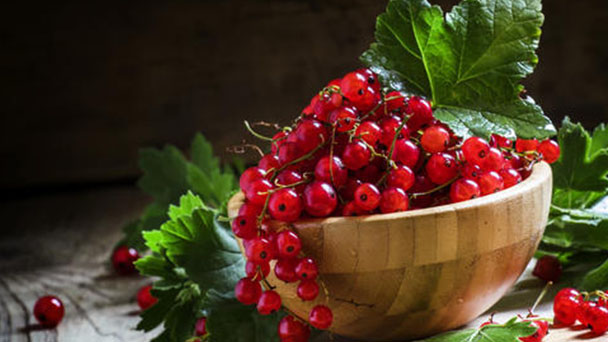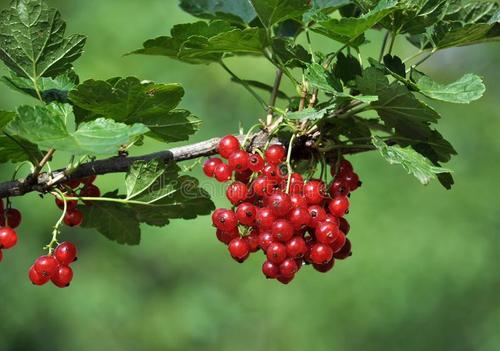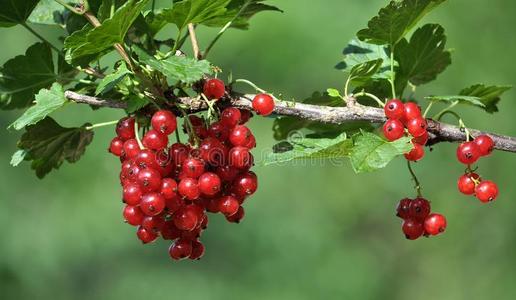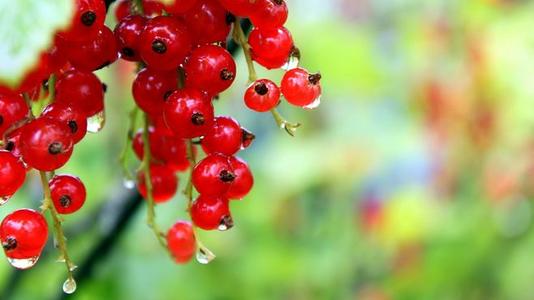Redcurrant profile
Written by Maggie
Jan 30 2021

Redcurrant is a small shrub of Currant family, Currants and Currants. The plant height is 1 ~ 115 m. The fruits are grown in clusters on the fruit branches. Redcurrant is one of the important economic tree species in China. Its fruit is sweet and edible. It can be used as canned fruit, jam, wine, beverage, etc. It has high economic value and can also be used as ornamental tree species. Redcurrant is used to treat fatigue, visual impairment and arthritis. Redcurrant patches are effective in the treatment of skin diseases. Redcurrants are also often dried and used in pastries to add flavor. Redcurrant seed oil is rich in linolenic acid, which is mainly found in vegetable oils.
Redcurrant picture

Redcurrant morphological characteristics
Redcurrant is a small shrub of Currant family, Currants and Currants. The plant height is 1 ~ 115 m. The fruits are grown in clusters on the fruit branches. Redcurrant is one of the important economic tree species in China. Its fruit is sweet and edible. It can be used as canned fruit, jam, wine, beverage, etc. It has high economic value and can also be used as ornamental tree species.
Redcurrant place of origin
Redcurrant is mainly distributed in Europe, and its cultivated area and yield rank first in the world. The history of Chinese gooseberry cultivation has been more than 80 years. Redcurrant main production areas are in Heilongjiang and Jilin provinces, and Inner Mongolia, Gansu and other provinces and regions also have a small number of introduction and cultivation. The main cultivars of Redcurrant are mostly black currant. There is no relevant report on the introduction and cultivation of Redcurrant in China.
Redcurrant propagation methods
Redcurrant propagation in Russia is mainly propagated by cuttings in protected areas, with a high survival rate and fast propagation speed. After the introduction of the Redcurrant species in China, the propagation method was used to shoot cuttings under all-light spray conditions, and good results were obtained.
Redcurrant growing methods
Garden choice: Redcurrant like neutral to slightly acidic soil, in the deep soil layer, hummus, loose fertile soil growth well, but saline-alkali soil, white clay soil is not suitable for planting.The garden is better to be flat, full of light. The slope is not more than 10 degrees of the gentle slope is more appropriate.
Planting: The planting time of Redcurrant can be carried out in spring and autumn. In spring, after the soil thaw can be planted. In autumn, immediately after the seedling planting, irrigation, and then buried soil against cold. Autumn planting of Redcurrant can save the process of storage of seedlings, and early spring germination growth early, high survival rate, robust growth.
Before colonization, planting holes should be dug, the size of which is 30cm×30cm, and 10-15kg of decomposed farmyard fertilizer should be applied to each hole. Generally, the proper spacing of the rows is 1.5m× 1.0m or 2m× 1m. Redcurrant is a hermaphroditic flower and self-fruiting. In order to increase the fruit-setting rate, it is better to plant two varieties in the same orchard to increase the pollination rate and ensure the fruit yield.
Soil management
First planting Redcurrant garden, normal weeding and soil removal between plants can be carried out, and intercropping can be carried out between rows. The type of intercropping is suitable for legume crops of highland barley, and the principle of not affecting the normal growth and development of Redcurrant can improve the land utilization rate and comprehensive benefits. As the growth and development of Redcurrant trees, when the crown reaches Yu closed, it is unfavorable to replant crops at this time. The main management is medium tillage and weeding, and the depth of soil loosening is 10 ~ 15cm. During a growing season, plow and weed 4 to 6 times.
Fertilization
Apply asal fertilizer to organic fertilizer for Redcurrant. The organic fertilizer was 30 ~ 40t/hm2 in the mature garden. General application of organic fertilizer every 2 years 1 time. The trenching method was adopted, that is, the trenches were 10 ~ 20cm deep between rows 30cm away from the root system, fertilizer was applied into the trenches, and then the soil was covered.
Topdressing According to the growth of the Redcurrant tree body, different periods of topdressing different fertilizers. Generally, top dressing is carried out 2 times a year. A fertilizer based on nitrogen and potassium was applied, 50-100g to each bush. The second time was in summer. Phosphorus and potassium fertilizers were mainly applied to Redcurrant, with 50 ~ 100g applied to each bush. Topdressing was carried out by ditch application or combined with intertillage, and irrigation was carried out after fertilization.
The suitable fertilizers for extra-root fertilization include 0.3% ~ 0.5% urea, 0.3% ~ 0.5% potassium dihydrogen phosphate, 0.5% ~ 3% potassium perphosphate leaching solution, 3% ~ 10% plant ash leaching solution, etc. Extra-root fertilization should be sprayed in the evening when the temperature is low and humidity is high. During the whole growing season of Redcurrant, extra-root topdressing should be carried out at any time according to the growing needs of the plant.
Irrigation and drainage
Sprout accelerating water: can be carried out in spring, conducive to the growth and development of Redcurrant trees;
Fruit setting water: It is carried out in the middle of spring. This irrigation is beneficial to flowering, fruit setting, young fruit development and new shoot growth of Redcurrant.
Fruit water: in the middle of summer, to promote fruit expansion, flower bud differentiation and root rapid growth has obvious effect;
Freezing water: before the soil freezes, to prevent the drying and death of Redcurrant trees due to physiological drought.
Plastic pruning
The aboveground part of Redcurrant is composed of branches of various ages. As the growth of the branches weakened, it must be promptly pruned.
Pruning in dormant period: Pruning before sprout in spring. Each bush of currant leaves 16 to 20 basal shoots, which can be retained for 3 to 4 years.In the spring of the first year of seedling planting, 4 ~ 5 buds were kept for repruning, and 4 ~ 5 healthy basal branches were kept and selected in the same year. In the second to fourth year, 4 to 5 basal shoots of Redcurrant were kept for each of them. This constitutes a cluster of three to five plants with one - to four-year-old basal branches. After 16 to 20 basal branches of Redcurrant were retained, 4 to 5 weak-growing and poorly fruiting 4-year old basal branches were thinned from the base each year, and 4 to 5 new basal branches were retained as supplementary branches. For drooping, overdense or pests and diseases to cut off the branches in time.
Summer pruning: It refers to pruning Redcurrant in the growing season. Generally, the appropriate period is before and after falling flowers, and 7 ~ 8 basic branches are selected for each plant cluster. Summer pruning is mainly to remove sprout, cutting off overcrowded branches, diseased branches, dead branches and senile branches.

Redcurrant pest control
Powdery mildew is the main disease of redcurrant. The disease harms the whole plant, resulting in the slow growth of Redcurrant trees, resulting in fruit shedding, serious branches dead.
Prevention and control methods: before germination, spray cloth bomei 3 ~ 5 degrees of sulfur mixture; At the beginning of the disease, spray 20% powder rust emulsion 800 ~ 1000 times the liquid, or 50% tobujin wettable powder 500 ~ 600 times the liquid. Spray once every 2 weeks and then once again after picking the fruit. See-feather moth, mainly harmful to currant stems. Larvae drill inside the stem, string feeding pulp, stem outside the exit of red feces. Endangered branches grow weakly, severe branches withered leaves fall. The drugs used are 1000 times 50% dichlorvos emulsion, spraying once every 2 weeks, or 1000 times 50% phoxim emulsion. It should not be used 10 days before fruit picking. Aphids and blastocoel mainly harm the top leaves of new Redcurrant shoots, and the seriously damaged leaves and shoots cannot continue to grow. In the Redcurrant growing season, spray 1200 ~ 1500 times of diethoate or diethoate cream or oxidize diethoate 2000 ~ 3000 times of liquid. In the larva 1 to 2 instars, the control effect was better by spraying 800 times of quickzizaiding solution.
Redcurrant viewing and other use-value
Fruit size, fruit weight and storability of Redcurrant were lower than those of RibesnigrumL, but the fruit process maturity was higher, and the storability was negatively correlated with oxidative metabolism intensity. In the process of fruit processing, the content of ascorbic acid decreased gradually with the prolonging of heating and concentration time. Redcurrant root system developed, the cold cold-resistant ability is strong, and handsome and elegant, with pale green green green purple flowers numerous color, grain forms, if annatto red Dan, glittering and translucent get rid of is appeared, ornamental value is extremely high, to adorn the roadside or flower bedside, beautiful style, to flowers and beautiful building one of the trees, flowers and buds of the ecological city is rich in aromatic oil, is a good honey plant, and wild hardiness, disease resistance and high sex are extremely strong, can serve as good breeding and hybrid parent material. The content of crude protein in the leaves of Redcurrant is high. The further processed products are of great significance to the development of animal husbandry, to solve the problem of grass shortage for livestock in winter, to alleviate the contradiction between agriculture, forestry and animal husbandry, and to promote the regional ecological construction and the healthy economic development.

Latest Updated
- Benefits of Bugleweed - 7 Science-backed Health Benefits
- Bugleweed Dangers & Side Effects - Is It Poisonous?
- How to Plant Evergreen Trees - What You Should Know
- When to Plant Evergreens - Grow Guide for Evergreen Trees
- 12 Wonderful Evergreen Shrubs for Your Garden
- 12 Popular Evergreen Plants with Pictures for Beginners
- When And How To Prune A Lilac Bush Like a Pro
- How to Grow & Care for Lilac Vine (Hardenbergia Violacea)
- Japanese Lilac Tree (Syringa Reticulata) Care & Propagation Guide
- Shumard Oak Pros and Cons - What to Know
Popular Articles
- Winter maintenance of Antirrhinum Majus
- How to Grow Terminalia Mantaly Tree
- How to Grow and Care for Crossostephium Chinense
- How to grow Antirrhinum Majus in spring
- Peristeria Elata (Dove Orchid) Profile: Info & Care Guide
- Underwatered Snake Plant (Sansevieria Trifasciata) - Signs And How To Fix
- How to Care for Brazilian Jasmine Plant (Mandevilla Sanderi)
- How to Grow & Care for Graptopetalum Purple Delight in Summer
- Rosa Chinensis (China Rose): Plant Growing & Care Tips
- How to Care for Baby Sun Rose (Aptenia Cordifolia)